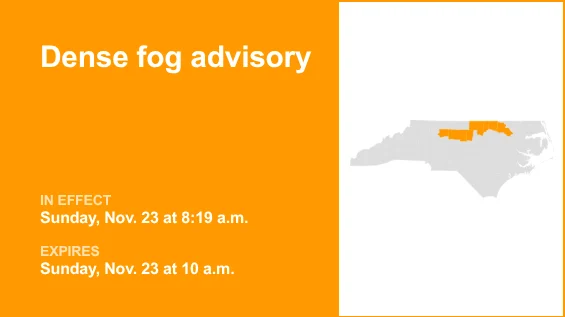Dense fog advisory for the Piedmont region Sunday morning, says the NWS

The creation of this content included the use of AI based on templates created, reviewed and edited by journalists in the newsroom. Read more on our AI policy here.
At 8:19 a.m. on Sunday, the NWS Raleigh NC released a dense fog advisory in effect until 10 a.m. The advisory is for Person, Granville, Vance, Warren, Halifax, Forsyth, Guilford, Alamance and Orange counties.
“Visibility of 1/4 mile in dense fog,” can be expected according to the NWS. “Conditions should begin to improve after 9 a.m., and the fog should lift by 10 a.m.”
“Low visibility could make driving conditions hazardous,” describes the NWS. “If driving, slow down, use your low beam headlights, and leave plenty of distance ahead of you. If driving, be on the lookout for sudden changes in visibility, especially when driving near bodies of water.”
This advisory is in effect until 10 a.m.
Driving in foggy conditions
A dense fog advisory is issued by your local National Weather Service office when widespread dense fog develops. When this happens, visibilities frequently drop to one-quarter of a mile or less. These conditions make travel difficult. Take extra caution when on the road or avoid driving if possible.
If you must drive in foggy conditions, keep the following safety tips in mind:
- Slow down and allow extra time to reach your destination.
- Make your vehicle visible to others both ahead of you and behind you by using your low-beam headlights since this means your taillights will also be on. Use fog lights if you have them.
- Never use your high-beam lights. Using high-beam lights causes glare, making it more difficult for you to see what’s ahead of you on the road.
- Leave plenty of distance between you and the vehicle in front of you to account for sudden stops or changes in the traffic pattern.
- To ensure you are staying in the proper lane, follow the lines on the road with your eyes.
- In extremely dense fog where visibility is near zero, the best course of action is to first turn on your hazard lights, then simply pull into a safe location such as a parking lot of a local business, and stop.
- If there is no parking lot or driveway to pull into, pull your vehicle off to the side of the road as far as possible. Once you come to a stop, turn off all lights except your hazard flashing lights, set the emergency brake, and take your foot off of the brake pedal to be sure the tail lights are not illuminated so that other drivers don’t mistakenly run into you.
Source: The National Weather Service
This story was originally published November 23, 2025 at 8:23 AM.





